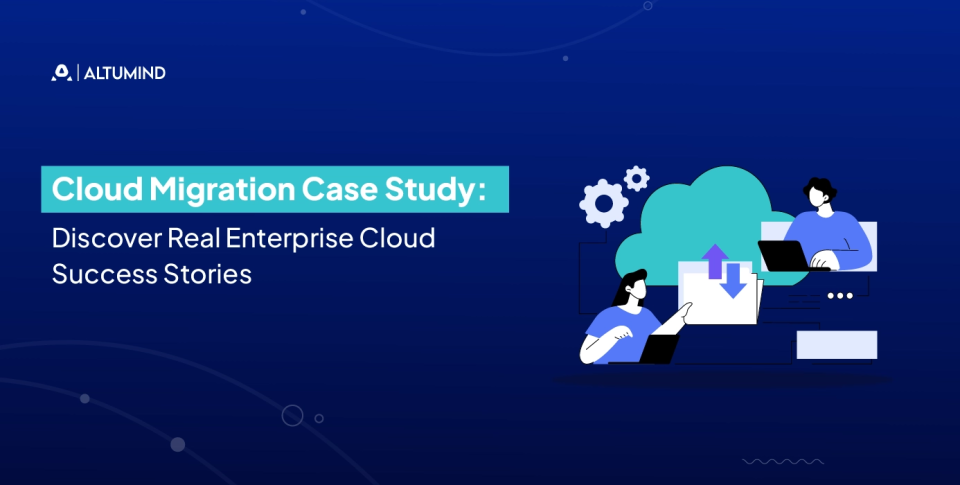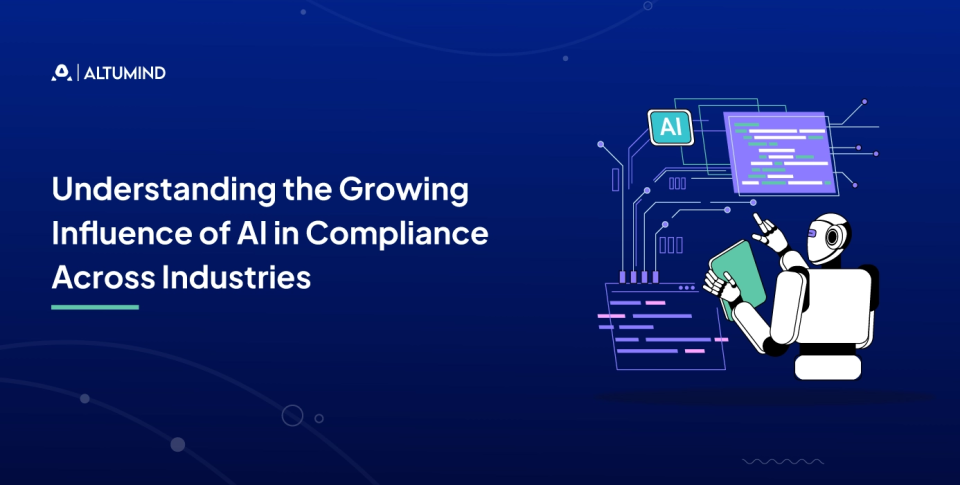A Practical Guide to Digital Product Development for Business Leaders
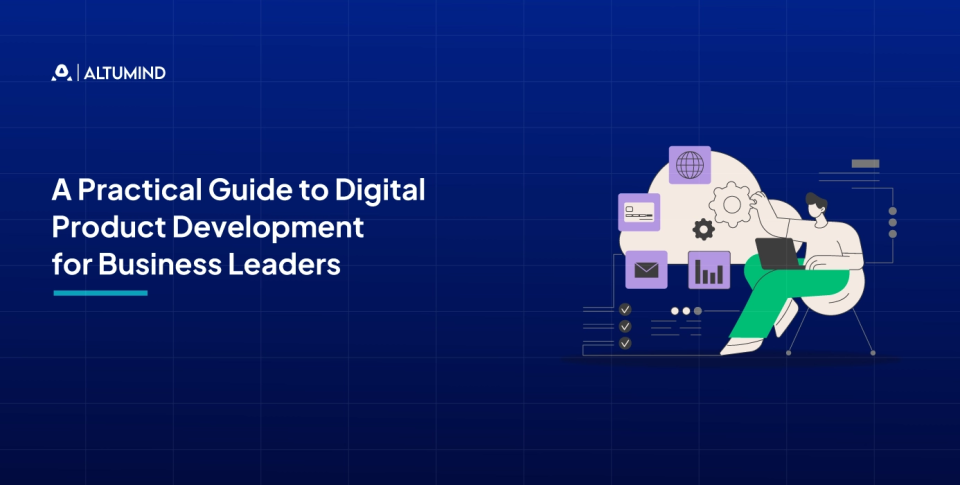
Every business is racing to stay relevant in a digital-first world. Traditional models, once built for stability, now struggle to match the speed of customer expectations. Products that once took years to design and launch must now evolve in months. The distance between business ambition and digital capability continues to grow, slowing innovation and performance.
This disconnect often leads to missed opportunities and wasted investment. Teams develop features that fail to meet real user needs, while leaders invest in technology that does not align with strategic priorities. Competitors that adapt faster gain the advantage, leaving others caught in cycles of reactive decision-making instead of deliberate growth.
Digital product development changes that story. It unites strategy, technology, and user insight into one continuous system of innovation. With it, companies move from static planning to agile creation, turning ideas into scalable digital products that adapt to user needs and business goals in real time. In this blog, we’ll understand about digital product development, its benefits, and how to find a reliable solution provider.
What is Digital Product Development?
Digital product development turns business ideas into purposeful digital solutions. It blends design, technology, and data into a structured process that delivers results for both users and the organization.
Unlike conventional software projects that focus only on development and delivery, digital product development continues after launch to improve performance and user experience. It treats every product as an evolving system that learns from real-world feedback.
Each phase, from concept to refinement, connects customer needs with measurable business goals. This approach gives every product a purpose and a path for growth. It helps organizations adapt faster and respond to changing customer expectations without starting from scratch each time.
Digital product development typically includes:
- Customer-centric products such as mobile apps, portals, and marketplaces that improve engagement.
- Enterprise-grade systems that automate operations and connect digital workflows.
- Intelligent products that use data and AI to predict needs or personalize experiences.
Platform ecosystems that bring together services into one cohesive experience.
By partnering with a reliable digital product development service provider, businesses can build effective solutions and gain a repeatable method for innovation. It allows them to convert strategy into tangible outcomes while building products that evolve with time, technology, and users.

Types of Digital Products
Digital products represent every software-based solution that creates value for users and drives business growth. They have become the core of enterprise innovation, fueling how companies build, connect, and scale. In fact, global spending on digital transformation is expected to reach $3.9 trillion by 2027, showing how rapidly businesses are investing in digital-first strategies.
Mobile Applications
Mobile apps remain the most common form of digital product. They create direct, personalized connections with customers and provide on-demand access to services. In 2023, the global Internet of Things (IoT) market reached $318 billion, with $226 billion attributed to software such as mobile applications. This highlights how mobility now shapes every customer journey.
Web and Cloud Applications
Web-based and cloud-native products help organizations deliver consistent performance across devices. They support scalability, remote collaboration, and rapid deployment. These products power portals, collaboration tools, and business management systems that strengthen user engagement and operational efficiency.
Enterprise Software Solutions
This category includes ERP, CRM, and automation platforms that simplify complex business operations. They connect teams, data, and processes for faster decision-making. Enterprise IT services are driving digital transformation, forming the backbone of this progress, helping companies modernize legacy systems, adopt cloud solutions, and improve governance.
Intelligent and Data-Driven Products
AI-powered tools and analytics platforms turn data into insights that guide smarter strategies. They learn from behavior, predict trends, and personalize interactions in real time. This approach gives organizations deeper visibility into performance and customer behavior.
Digital Ecosystems and Platforms
These systems combine multiple digital products into a unified experience. Examples include integrated marketplaces, fintech platforms, and supply chain management solutions. They allow enterprises to expand reach, diversify revenue, and scale globally with agility.
The expanding demand for connected, intelligent, and adaptable solutions confirms one truth: digital product development is the foundation of how modern enterprises compete and grow.
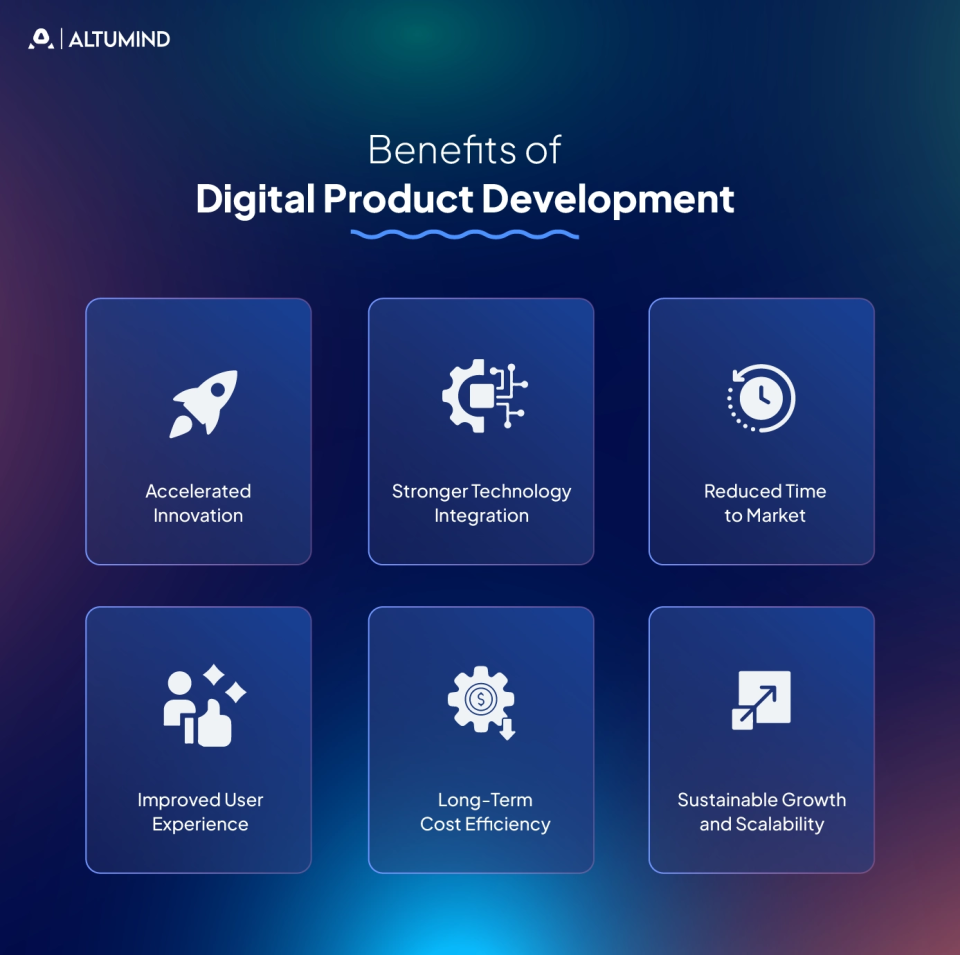
Benefits of Digital Product Development
Digital product development provides measurable business outcomes. It connects technology, strategy, and user insight to deliver products that perform and evolve. Companies adopting this model experience stronger innovation, higher efficiency, and greater adaptability across functions.
Accelerated Innovation
This approach supports faster idea testing and product improvement. Teams work in shorter cycles that allow continuous learning and quick validation. Businesses can release new features sooner while reducing the risks of large, inflexible projects.
Stronger Technology Integration
Cloud, AI, and the Internet of Things are the top three areas companies are scaling up during digital transformation, according to Accenture. When applied through digital product development, these technologies improve data flow, process automation, and customer engagement.
Reduced Time to Market
Agile frameworks, automated testing, and cross-functional collaboration shorten product timelines. Enterprises can move from concept to launch with greater precision. This adaptability helps them stay ahead in markets where timing defines success.
Improved User Experience
User research and continuous feedback remain central to every phase of digital product development. Products are designed around user behavior, creating seamless experiences that increase satisfaction and brand trust.
Long-Term Cost Efficiency
Streamlined workflows and reusable frameworks reduce development and maintenance costs. The application development software market is projected to generate $195.77 billion in revenue by 2025, reflecting how organizations are prioritizing scalable, efficient digital systems.
Sustainable Growth and Scalability
Digital product development builds flexible systems that support future expansion. Cloud-native structures, automation, and analytics allow products to adapt to new business goals and market opportunities without major rework.
Challenges in Digital Product Development
While digital product development drives innovation and growth, it also introduces new layers of complexity. Many organizations face strategic and operational barriers that affect speed, quality, and adoption. Understanding these challenges helps leaders plan realistic, outcome-driven digital initiatives.
Misalignment Between Business Goals and Product Vision
A common challenge occurs when product strategies do not reflect business objectives. Teams may focus on features instead of outcomes, which leads to products that fail to deliver measurable value. Alignment between leadership, product, and technology teams is essential from the start.
Limited Collaboration Across Departments
Digital product development requires input from multiple functions such as marketing, design, IT, and analytics. When these teams work in isolation, decision-making slows down and innovation suffers. Collaboration tools and shared accountability can help close these gaps.
Technical Debt and Legacy Systems
Older systems often restrict integration with modern technologies. They add cost and limit scalability. Managed IT services help organizations modernize legacy infrastructure, improve reliability, and maintain smooth performance during digital transformation.
Data Management and Security Risks
Data drives every stage of digital product development. Weak governance or inconsistent data handling can create compliance and security challenges. Implementing AI in compliance enables continuous monitoring, accurate reporting, and early risk detection, helping businesses protect both customer trust and regulatory standing.
Skill Gaps and Resource Shortages
Advanced digital products need talent in AI, cloud, and analytics. Many enterprises struggle to find or retain this expertise. Partnering with managed IT services providers helps bridge these gaps by offering specialized knowledge, scalable resources, and continuous technical support that internal teams can build upon.
Measuring Success Effectively
Without clear metrics, it becomes difficult to evaluate whether a product meets business goals. Companies should define performance indicators tied to customer satisfaction, adoption rates, and ROI from the very beginning.
Digital product development brings clear rewards but also demands consistent alignment, modern infrastructure, and a culture of learning. Addressing these challenges early transforms complexity into a foundation for innovation.
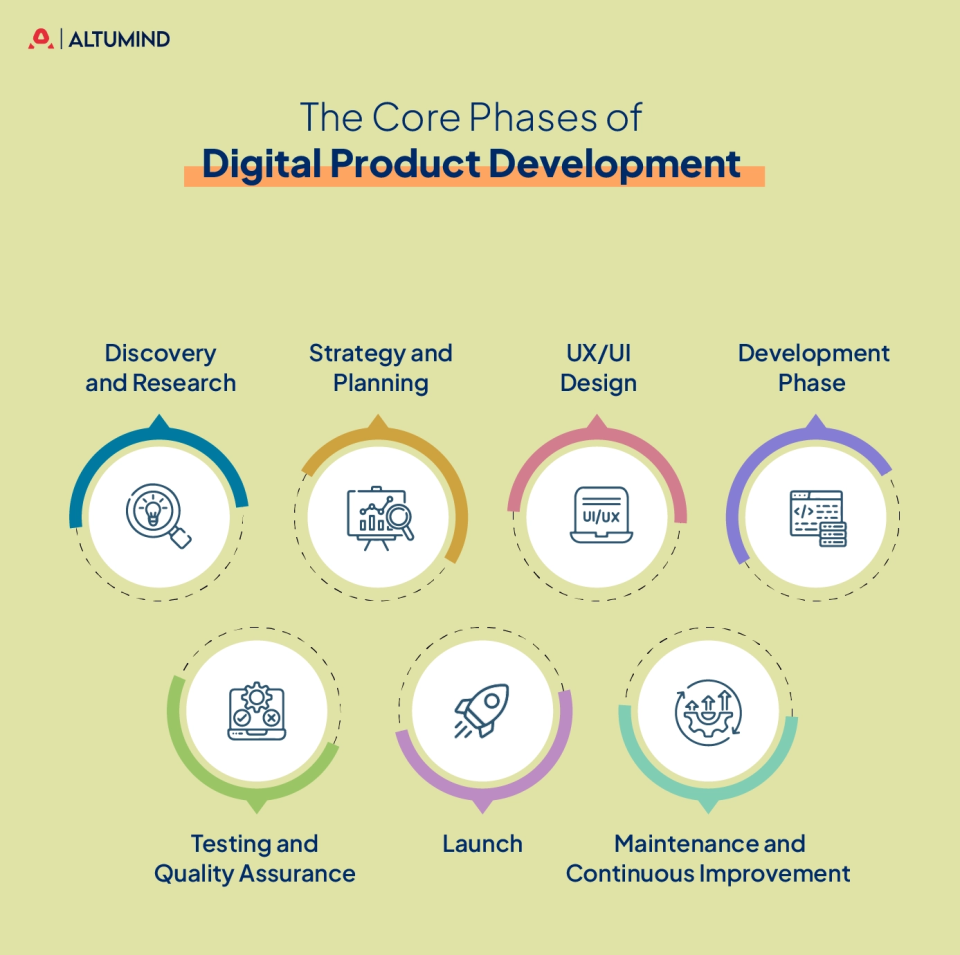
The Core Phases of Digital Product Development
Digital product development is a strategic process that blends research, planning, design, technology, and continuous improvement. Each stage contributes to building solutions that are not only functional but meaningful to both users and the business.
Discovery and Research
Every strong digital product begins with understanding the problem it must solve. The discovery phase helps teams define purpose, direction, and opportunity. It focuses on identifying market gaps, user pain points, and business alignment before any design or coding begins.
This stage involves market studies, stakeholder interviews, and competitor analysis to validate whether the idea is viable and valuable. Teams also develop user personas to capture how the target audience behaves and what motivates their decisions.
Before building a healthcare scheduling platform, for instance, research might reveal that most patients prefer mobile booking and instant confirmations. That insight shapes both the product strategy and its technical requirements.
Key questions to consider include:
- What business challenge or user need is this product addressing?
- How large is the opportunity, and does it justify investment?
- How does this concept fit within the company’s digital vision?
Strategy and Planning
Once the idea is validated, the focus shifts to turning insight into action. Strategy and planning define how the product will be built, delivered, and measured.
This phase sets goals, timelines, budgets, and the overall development roadmap. Teams prioritize which features to launch first, often through an MVP approach, and decide on the right technology stack to support scalability.
A logistics company creating a delivery-tracking platform, for example, might begin with route optimization and driver updates before expanding into predictive analytics. By doing so, the product gains market traction quickly while allowing future growth.
To build a strong foundation, decision-makers should ask:
- Which features bring immediate value to users?
- Does our technology choice support integration and long-term scale?
- What resources are required for sustainable delivery?
UX/UI Design
At this stage, the product begins to take visual and interactive form. Designers translate strategy into a human-centered experience, balancing functionality with aesthetic appeal.
User experience design defines how users interact with the product, while user interface design shapes its visual personality. Together, they make complex systems simple and intuitive.
Wireframes and prototypes allow teams to test ideas early. A financial management app, for example, might use visual dashboards to help users quickly track spending and savings goals. Continuous user feedback during design helps refine navigation and usability before moving into development.
Questions that guide this phase include:
- Does the design simplify the user’s journey?
- Are accessibility and responsiveness built into the interface?
- How well does the visual identity reflect the product’s purpose?
Development Phase
Once the design is approved, the engineering process brings it to life. Developers build the front end, set up databases, configure servers, and integrate APIs to create a working product.
Modern development emphasizes agility, scalability, and security. Teams often use iterative sprints, where features are coded, tested, and refined in short cycles. This keeps progress visible and allows adjustments without losing momentum.
For example, an eCommerce brand developing a new app might integrate real-time inventory APIs to display product availability instantly. This simple yet impactful feature directly enhances the user experience and reduces abandoned carts.
Leaders should ensure that:
- Security and compliance standards are implemented early.
- The development team uses clean, maintainable code practices.
- Documentation supports scalability and future upgrades.
Testing and Quality Assurance
Testing is the gatekeeper of reliability. Before a product is released, it must prove that it performs well under real conditions. This phase involves multiple layers of testing: functional, usability, performance, and security.
Thorough validation ensures that the product behaves as expected, loads quickly, and protects user data. When a fintech company simulates high transaction volumes before launch, it is to confirm that systems remain stable during peak hours.
Business leaders should ask:
- Have all critical workflows been tested under realistic conditions?
- Is user feedback incorporated into final revisions?
- Are there safeguards in place to maintain performance after updates?
Comprehensive testing not only prevents post-launch issues but also builds user trust from day one.
Launch
The launch phase delivers the product to real users and transforms months of planning into measurable impact. Deployment includes preparing production environments, managing platform submissions, and coordinating marketing efforts.
A successful launch is both technical and strategic. It involves close monitoring of early user behavior, collecting feedback, and addressing any emerging issues quickly. A learning management company, for instance, might release its app to a limited group first, refine the experience based on user feedback, and then roll it out globally.
To guide this stage, teams should consider:
- Is the deployment process automated and reversible if errors occur?
- How will user feedback be gathered and prioritized post-launch?
- What indicators will define success within the first release cycle?
The goal is to deliver a seamless entry into the market that feels effortless to the user and stable to the organization.
Maintenance and Continuous Improvement
Once the product is live, the real work begins. Markets evolve, technologies advance, and user expectations shift constantly. Continuous improvement keeps a product relevant, resilient, and competitive.
This phase involves regular monitoring of performance metrics, releasing updates, fixing bugs, and adding new features based on data insights. Feedback loops help teams identify what users value most and where experience gaps still exist.
A food delivery company might notice delays in order updates during peak hours. By analyzing usage data, developers can optimize delivery algorithms and push updates that improve accuracy and reduce wait times.
Key questions include:
- Are product updates informed by real user behavior?
- How quickly can the team respond to technical or performance issues?
- Does the product roadmap account for emerging technologies like AI or automation?
This is also the phase where the role of a digital product development company becomes indispensable. Experienced partners bring long-term technical management, proactive monitoring, and strategic foresight to help businesses scale confidently.
They combine analytics, automation, and engineering discipline to ensure that every release adds measurable value.
Continuous improvement transforms a product from a static tool into a growing digital ecosystem that evolves alongside the business and its customers.
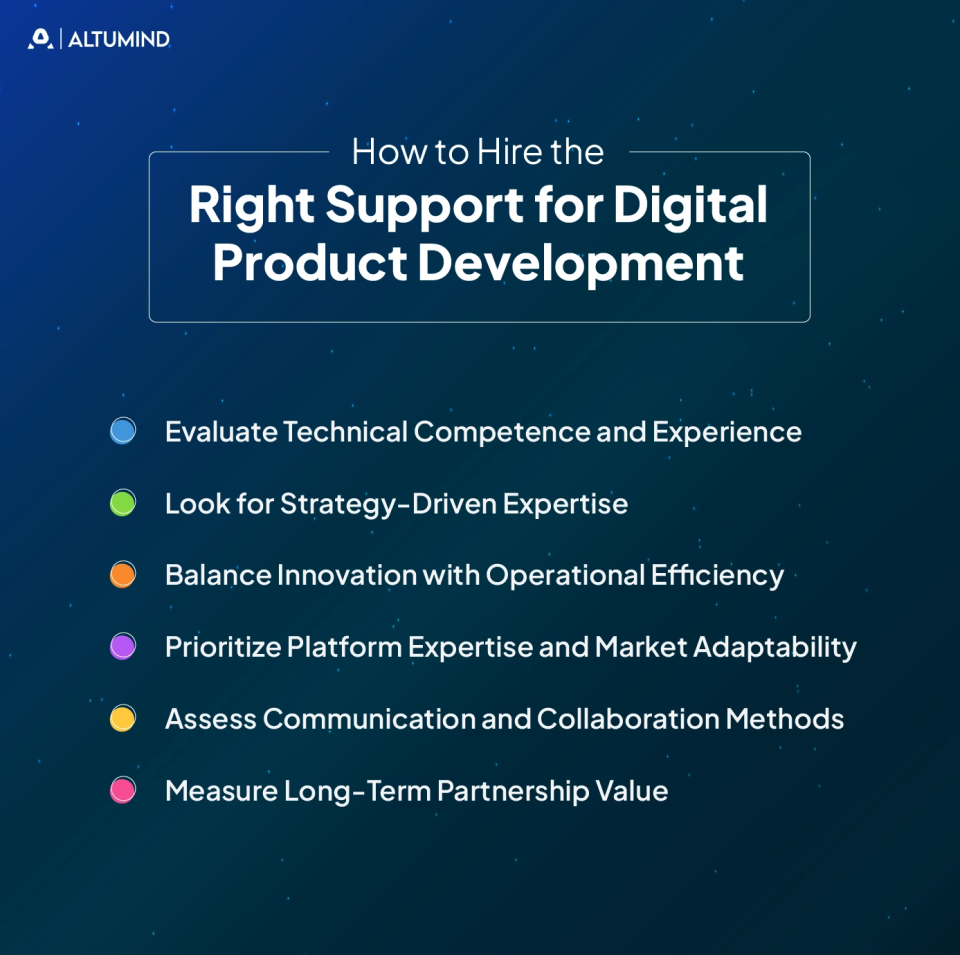
How to Hire the Right Support for Digital Product Development
According to Infosys, 53% of organizations say finding the right technology solutions is a major concern in workplace transformation. The challenge is not the shortage of tools but the ability to choose a partner who aligns technology with long-term goals. Selecting the right support for digital product development determines whether innovation becomes a sustainable business asset or remains an unfinished concept.
Evaluate Technical Competence and Experience
A capable partner must bring experience across industries and technologies like AI, cloud, and automation. Their role is to connect business intent with the right technology stack.
When evaluating technical expertise,
consider:
- What technologies and tools do they specialize in?
- How do they ensure security, scalability, and performance?
- Can they integrate advanced capabilities such as AI in compliance or IoT-driven intelligence?
This evaluation helps you find a team that builds solutions equipped for today and ready for tomorrow.
Look for Strategy-Driven Expertise
Working with a digital product development consultancy bridges the gap between technology and business strategy. The right consultancy goes beyond execution to create a roadmap that drives measurable outcomes.
They typically:
- Analyze your existing digital maturity and user expectations.
- Define clear goals tied to revenue, efficiency, or market expansion.
- Offer continuous improvement plans for post-launch performance.
This ensures every digital product supports business growth and customer satisfaction.
Balance Innovation with Operational Efficiency
Deloitte reports that IT departments spend an average of 56% of their budget on maintenance. Whatever your budget is, the right partner should help you use it fully for growth rather than upkeep. The right team does this
through:
- Automation that minimizes repetitive work.
- Smart monitoring systems powered by analytics.
- Scalable cloud infrastructure that reduces downtime and manual effort.
When resources are optimized, innovation becomes a steady part of the business rather than a side project.
Prioritize Platform Expertise and Market Adaptability
In the global market, Android continues to dominate with 73.9% share as of Q4 2024, ahead of iOS. Yet with changing times, these figures can shift quickly as new devices, platforms, and AI technologies emerge. A strong digital product development service provider stays
adaptable by:
- Building flexible, cross-platform solutions that evolve with user demand.
- Integrating new tools like AI-driven testing or predictive analytics.
- Continuously refining apps to stay current with market and system updates.
Adaptability ensures that your product remains relevant no matter how user preferences or technologies change.
Assess Communication and Collaboration Methods
Clear communication keeps every phase of digital product development on track. Look for a partner who values transparency, offers structured updates, and invites real-time input from your internal teams. Consistent collaboration builds accountability and trust throughout the lifecycle.
Measure Long-Term Partnership Value
Digital product development is an ongoing relationship, not a one-time contract. A strong partner should evolve alongside your business, introduce emerging technologies, and keep your product aligned with new regulations and market shifts.
Ask yourself:
- Does this partner think beyond project delivery?
- Can they support upgrades, optimization, and scaling in the future?
- Do they invest in understanding your business model along with the tech stack?
The right support system turns technology into a growth engine. Every decision made today on tools, platforms, and people should lead to products that adapt, scale, and perform in the real world.
Conclusion
Digital transformation is no longer about adopting technology. It is about building digital products that deliver measurable business outcomes. Effective digital product development connects innovation, agility, and strategic insight to help organizations turn ideas into scalable digital assets.
Every phase, from discovery to continuous improvement, defines how efficiently a business can evolve in a competitive environment. The right digital product development services empower enterprises to reduce complexity, enhance customer experience, and adapt faster to market shifts.
At Altumind, we help business leaders turn ideas into value-driven digital solutions. Our teams blend data, AI, automation, and modern engineering to design products that are secure, scalable, and ready for the future. With deep industry experience and a client-focused approach, we provide complete support across every stage of the product lifecycle, from concept to continuous improvement.
Digital product development is a long-term capability that shapes how organizations grow. With the right partnership, technology becomes a business enabler, driving innovation, efficiency, and sustainable success.
Let's Connect
Reach out and explore how we can co-create your digital future!


